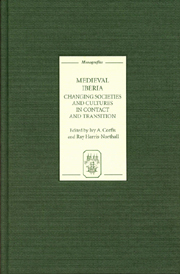Book contents
- Frontmatter
- Contents
- Acknowledgements
- Introduction
- Part 1 SOCIAL AND CULTURAL MINORITIES IN CHANGING SOCIETIES
- The Converso Condition: New Approaches to an Old Question
- Speaking through Many Voices: Polyphony in the Writings of Teresa de Cartagena
- Chains of Iron, Gold and Devotion: Images of Earthly and Divine Justice in the Memorias of Doña Leonor López de Córdoba
- Part 2 CONTACT AND CONFLICT: PERSPECTIVES ON HISTORY AND CULTURE
- Part 3 TRANSMISSION OF LEARNING AND TEXTS IN CHANGING CULTURES
- Part 4 LINGUISTIC CONTACT AND CHANGE
- Index
Chains of Iron, Gold and Devotion: Images of Earthly and Divine Justice in the Memorias of Doña Leonor López de Córdoba
from Part 1 - SOCIAL AND CULTURAL MINORITIES IN CHANGING SOCIETIES
Published online by Cambridge University Press: 12 September 2012
- Frontmatter
- Contents
- Acknowledgements
- Introduction
- Part 1 SOCIAL AND CULTURAL MINORITIES IN CHANGING SOCIETIES
- The Converso Condition: New Approaches to an Old Question
- Speaking through Many Voices: Polyphony in the Writings of Teresa de Cartagena
- Chains of Iron, Gold and Devotion: Images of Earthly and Divine Justice in the Memorias of Doña Leonor López de Córdoba
- Part 2 CONTACT AND CONFLICT: PERSPECTIVES ON HISTORY AND CULTURE
- Part 3 TRANSMISSION OF LEARNING AND TEXTS IN CHANGING CULTURES
- Part 4 LINGUISTIC CONTACT AND CHANGE
- Index
Summary
Doña Leonor López de Córdoba (c.1362–1430) wrote one of Spain's first autobiographical narratives. Unknown for most of its existence, Memorias was rediscovered in the late eighteenth century. It did not attract much interest as a literary text, however, until Ayerbe-Chaux edited it in 1977. Since then, it has been included in many anthologies of medieval texts and become one of the most frequently-read works of the Spanish Middle Ages.
Many critics have studied it as an independent account of the death of Pedro I of Castile and of the execution of Leonor's father, Martín López de Córdoba, maestre of Alcántara and Calatrava. Others have explored the complex issues associated with an historical narrative written by a woman. No one has considered the extent to which Memorias is similar to other testimonials of the miracles of a particular Virgin, even though the narrative clearly states that it is an account of miracles performed on López de Córdoba's behalf, miracles that she hopes will be remembered after her death (‘sepan la relación de todos mis echos é milagros que la Virgen Santa Maria, me mostro, y es mi intención que quede por memoria’ [Ayerbe-Chaux 16]).
Accounts of miracles associated with an image of the Virgin in a particular church or sanctuary were often gathered into ‘miracle books’ containing depositions from witnesses who testify before a notary or a priest to the authenticity of the miracle(s) associated with the image.
- Type
- Chapter
- Information
- Medieval IberiaChanging Societies and Cultures in Contact and Transition, pp. 30 - 44Publisher: Boydell & BrewerPrint publication year: 2007

